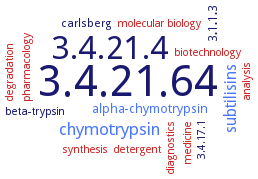3.4.21.64: peptidase K
This is an abbreviated version!
For detailed information about peptidase K, go to the full flat file.

Word Map on EC 3.4.21.64 
-
3.4.21.64
-
3.4.21.4
-
chymotrypsin
-
subtilisins
-
alpha-chymotrypsin
-
carlsberg
-
3.1.1.3
-
synthesis
-
degradation
-
beta-trypsin
-
diagnostics
-
analysis
-
pharmacology
-
molecular biology
-
medicine
-
detergent
-
3.4.17.1
-
biotechnology
- 3.4.21.64
-
3.4.21.4
- chymotrypsin
- subtilisins
- alpha-chymotrypsin
-
carlsberg
-
3.1.1.3
- synthesis
- degradation
- beta-trypsin
- diagnostics
- analysis
- pharmacology
- molecular biology
- medicine
- detergent
-
3.4.17.1
- biotechnology
Reaction
Hydrolysis of keratin, and of other proteins with subtilisin-like specificity. Hydrolyses peptide amides =
Synonyms
EC 3.4.21.14, EC 3.4.21.4, EC 3.4.4.16, endopeptidase K, mesophilic proteinase K, PROK, Proteinase K, Proteinase, Tritirachium album serine, Tritirachium album proteinase K, Tritirachium alkaline proteinase
ECTree
Advanced search results
Crystallization
Crystallization on EC 3.4.21.64 - peptidase K
Please wait a moment until all data is loaded. This message will disappear when all data is loaded.
computer modeling studies indicates the presence of a small binding pocket in the vicinity of the proteinase K active site, which may be filled by the aromatic phenylalanine moiety
crystallographic study of its complex with a dipeptide chloromethyl ketone inhibitor
-
Langmuir-Blodgett nanotemplate method and hanging drop vapor diffusion method, using 400 mM Na/K-tartrate in 25 mM HEPES pH 7.0
mercury-inhibited protein in presence of synthetic peptides GGGWGQPH and HGGGW, derived from N-terminal domain of human prion protein. Segment GGG is strongly bound as a substrate at the substrate recognition site
-
purified enzyme, oil microbatch method, mixing of 0.001 ml of 40 mg/ml protein solution in 50 mM MES-NaOH, pH 6.5, with 0.001 ml of precipitant solution composed of 250 mM NaNO3, 50 mM CaCl2, and 50 mM MES-NaOH, pH 6.5, to form Pr3+-derivatized crystals, the precipitant solution containing additionally 25 mM PrCl3 is used, X-ray diffraction structure determination and analysis at 1.45 A resolution
structure of the complex of proteinase K with a substrate analogue hexapeptide inhibitor at 2.2 A resolution, N-acetyl-L-Pro-L-Ala-L-Pro-L-Phe-D-Ala-L-Ala-NH2
-
the crystallization of proteinase K using PEG 8000 is performed at various degrees of solvent deuteration and X-ray crystallographic analysis at 1.1 A resolution confirms that deuteration has no effect on crystal quality or crystal structure in this case
-
three-dimensional structure of the complex of proteinase K with its naturally occuring protein inhibitor, PKI3
-
to 1.32 A resolution. final model contains two Ca2+ ions, a molecule of digalacturonic acid and a partially occupied HEPES molecule. The digalacturonic acid molecule has one sugar moiety disposed exactly on a crystallographic twofold axis and is bound through hydrogen-bonding networks involving residue S150 and water molecules
X-ray crystal structure at 1.5 A resolution shows that it has 2 binding sites for Ca2+
-


 results (
results ( results (
results ( top
top





